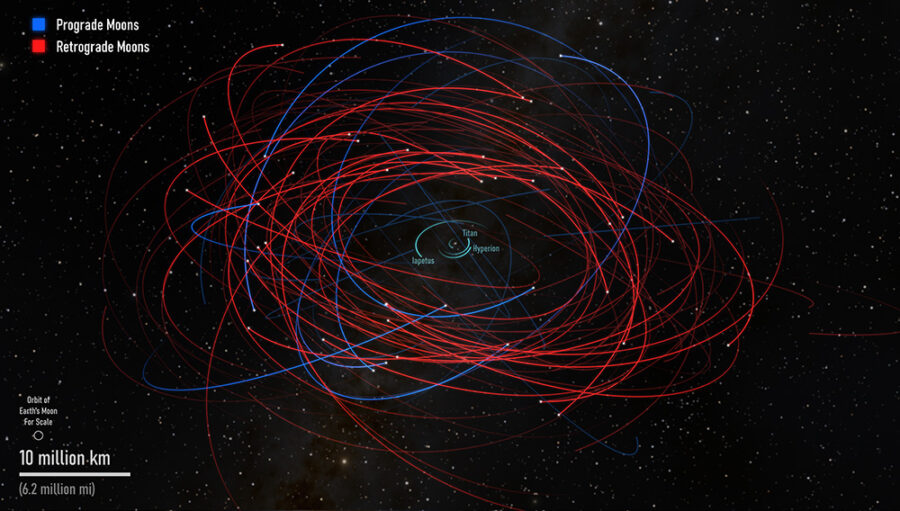The Minor Planet Center is announcing a bevy of new moons for Saturn that will bring its total to 145 (and break Jupiter’s record).

K Ly
Updates:
On May 22nd, the Minor Planet Center announced yet another moon, S/2006 S 20, bringing the total number to 146. Our table of Saturn's moons contains the full roster.
Saturn has reclaimed the record for most moons in the solar system with the discovery of 62 new moons. All are only a few kilometers in size and have orbits far from the planet that indicate their origin: Saturn captured these rocks at some point in the past.
As of press time, the Minor Planet Center (MPC) has published the orbits of 62 new moons in a series of announcements called Minor Planet Electronic Circulars, issued between May 3rd and 16th. That bring Saturn's total moon count to 145, including 24 “regular” moons, which formed around the planet, and 121 smaller, “irregular” moons on wide, elongated, and tilted orbits. The new reports more than double Saturn’s number of irregular moons, leaving Saturn far ahead of Jupiter’s 95 moons, which had put Jupiter in first place earlier this year.
The torrent of Saturnian discoveries comes from a series of observations that Edward Ashton (now at Academia Sinica Institute of Astronomy and Astrophysics, Taiwan), Brett Gladman (University of British Columbia, Canada), and colleagues, made with the Canada France Hawaii Telescope from 2019 to 2021. Their initial goal was to study the sizes of moons orbiting Saturn, and in 2021 they reported the size distribution of the small irregular moons. The larger amount of smaller moons indicates a recent (100 million years ago) collision between two objects around Saturn. To record faint moons down to a couple kilometers in size, the group stacked series of images, shifting each one to look for movement across images. Astronomers had previously used this method to search for moons around Uranus and Neptune, but it hadn't been applied yet to Saturn.
The group’s next project was to calculate orbits for the objects over the period for which the researchers had obtained observations. The process is laborious but essential and involves tracking the motion of small objects across the sky over time. “Linking [observations of] moons within the same year was fairly straightforward,” Ashton says, “but since there were only a few observations per year, linking the moons between different years was very time-consuming and involved a lot of trial and error.”
Orbit tracking is difficult. “These moons are far from the planet, their orbits are not trivial closed ones ... and you're seeing them from a moving Earth,” Gladman says.
The next step was to take the finds to the MPC. “We have been slowly submitting our observations to the MPC since 2020,” says Ashton. The center’s archives go back many years. Comparing new discoveries to archived objects is difficult because it requires running orbits backward over many years. At the same time, successfully matching a new object’s orbit with older observations improves the accuracy of its orbital parameters.
How many more Saturnian moons remain undiscovered? The 2021 survey covered only 2.2 square degrees of the 26 square degrees of sky in which Saturn's gravity dominates, a region called the Hill sphere. However, irregular moons rarely go more than more than half the radius of the Hill sphere from a planet, Ashton says: “In reality, about 75% of the known moons were in our fields at any one time.” In their 2021 paper Ashton and Gladman estimated that Saturn has roughly 150 irregular moons at least 3 kilometers (2 miles) in diameter. With about 120 such moons now known, Ashton says, “there are about 30 left [undiscovered] in this size range [and] likely many hundreds, if not thousands, of Saturnian moons with smaller sizes.”
Fortuitous discoveries of remaining moons are unlikely, says K Ly, an independent citizen scientist who specializes in archival astronomical data. An observer looking for something else would not be likely to recognize a new moon and would instead assume it was an unremarkable asteroid.
Editor's note (May 16, 2023): The last in the current series of new Saturn's moons was announced today.
 1
1








Comments
Rod
May 13, 2023 at 12:11 pm
Very good here. Just how long do these small moon orbits at Saturn? The ring age problem is back in the news.
New study puts a definitive age on Saturn's rings: They're really young, https://phys.org/news/2023-05-definitive-age-saturn-theyre-young.html
Ref - Micrometeoroid infall onto Saturn’s rings constrains their age to no more than a few hundred million years, https://www.science.org/doi/10.1126/sciadv.adf8537, 12-May-2023. "Abstract There is ongoing debate as to whether Saturn’s main rings are relatively young or ancient— having been formed shortly after Saturn or during the Late Heavy Bombardment. .."
You must be logged in to post a comment.
You must be logged in to post a comment.